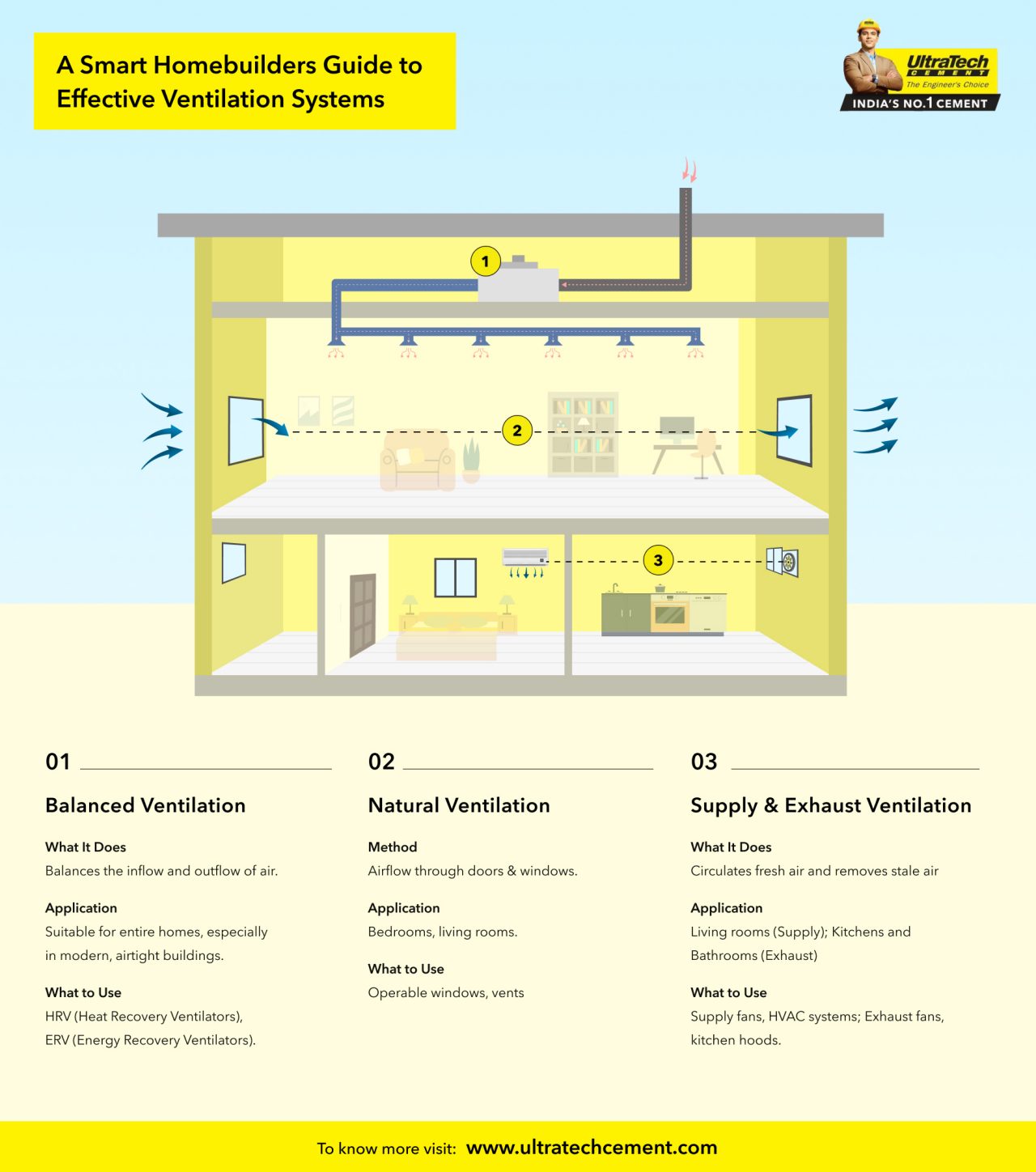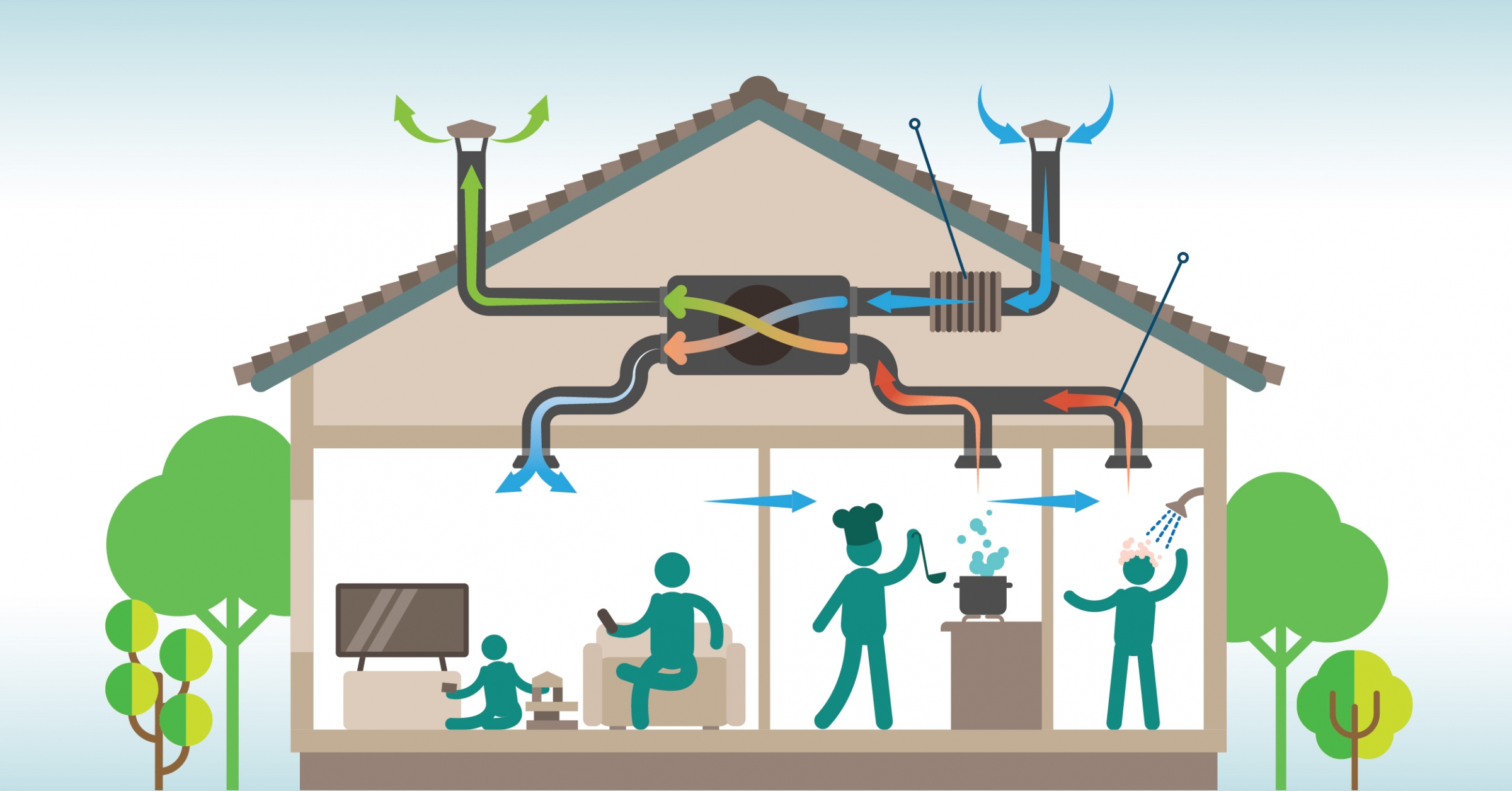Exploring Ingenious Solutions for Optimum Home Air Flow Systems
Home air flow plays an important role in keeping health and comfort within living rooms. With developments in innovation, cutting-edge services are arising to optimize these systems. Smart ventilation, power recovery ventilators, and advanced filtering are improving just how air top quality is managed - Home Ventilation Melbourne. The integration of these technologies raises concerns about their performance and adaptability in varied home atmospheres. What ramifications do these advancements hold for future living requirements?
The Value of Home Ventilation for Health and Comfort
Commonly ignored, home ventilation plays a vital function in keeping both health and wellness and comfort within domestic spaces. Adequate air flow is essential for the circulation of fresh air, which helps to dilute interior toxins such as unstable organic substances, irritants, and odors. Without appropriate airflow, these contaminants can gather, bring about breathing issues and various other health issue. In addition, reliable air flow adds to regulating moisture degrees, preventing mold and mildew development and structural damage. By ensuring a well balanced exchange of air, citizens can delight in an extra pleasant indoor environment, improving overall health. Adequate ventilation can enhance power efficiency by minimizing the demand for too much heating or cooling, eventually resulting in reduced utility costs and an extra sustainable living space.
Smart Ventilation Equipments: Harnessing Modern Technology for Efficiency
Smart ventilation systems stand for a significant innovation in home air management, leveraging IoT combination for boosted control. These systems not just advertise energy effectiveness yet also offer remote monitoring abilities, enabling customers to maximize their indoor atmospheres effortlessly. By using modern technology, property owners can accomplish enhanced air high quality while decreasing power intake.
IoT Assimilation Advantages
Just how can IoT assimilation change traditional ventilation systems right into highly reliable wise remedies? By including Web of Things (IoT) innovation, ventilation systems can accomplish real-time tracking and control, improving their operational performance. Sensing units put throughout a home gather information on air temperature level, humidity, and quality, enabling for automated modifications based on existing problems. This immediate responsiveness brings about enhanced indoor air high quality and comfort degrees. Furthermore, IoT-enabled systems can communicate with various other smart home tools, producing a natural ecological community that enhances power usage. Users can additionally gain access to and handle their ventilation systems remotely using smartphones, supplying convenience and raised control. In general, IoT combination represents a considerable development, bringing knowledge and flexibility to conventional air flow methods.
Energy Effectiveness Features
As energy effectiveness comes to be an essential emphasis in modern home design, advanced air flow systems offer cutting-edge attributes that greatly lower energy intake. These clever air flow systems make use of sensing units to keep an eye on indoor air humidity, temperature level, and top quality degrees, immediately readjusting air movement to maintain suitable problems. By employing energy recovery ventilators (ERVs), they catch and reuse power from outward bound air, decreasing heating and cooling demands. Variable speed fans even more improve effectiveness by readjusting their procedure based upon real-time needs, avoiding unnecessary energy waste - Home Ventilation Melbourne. Furthermore, programmable timers and tenancy sensing units assure that air flow operates only when required, adding to reduced energy costs. Jointly, these functions stand for a substantial advancement in creating energy-efficient and lasting living atmospheres
Remote Tracking Abilities
What advantages do remote monitoring abilities give modern-day home air flow systems? These abilities enable house owners to track indoor air quality and system performance in actual time, boosting general effectiveness. By offering data on air, temperature, and moisture toxins, clever ventilation systems make it possible for proactive adjustments, making sure optimal conditions. In enhancement, remote surveillance assists in maintenance informs, determining possible concerns before they rise, thus reducing repair service costs and downtime. Customers can access system analytics with mobile applications, enabling convenient control also when away from home. This technical integration not just promotes power efficiency but additionally contributes to a much healthier living atmosphere. Inevitably, remote tracking capabilities represent a substantial improvement in home air flow, aligning with the expanding need for wise home modern technologies.
Energy Healing Ventilators: Maximizing Energy Savings
Power healing ventilators (ERVs) play an essential function in boosting home power efficiency through effective warmth exchange. By transferring thermal energy in between outgoing and incoming air, these systems markedly decrease general power consumption. This ingenious strategy not just maintains interior air quality but likewise adds to decrease energy prices.
Efficiency of Warm Exchange
While preserving interior air top quality is important for health and wellness and convenience, the effectiveness of warmth exchange in power recovery ventilators (ERVs) plays an important role in maximizing energy savings. The main function of an ERV is to transfer heat and wetness in between inbound and outgoing jet stream, which maximizes indoor conditions while decreasing energy loss. High-efficiency warmth exchangers can considerably reduce the load on heating and cooling down systems by redeeming power that would otherwise be thrown away. The performance of these systems is frequently measured by their core temperature exchange prices, which can differ based upon style and materials used. By concentrating on innovative warmth exchange modern technologies, house owners can improve their ventilation systems, leading to boosted power effectiveness and expense reductions over time.
Lowered Power Consumption
Reducing power intake is a vital benefit of energy recuperation ventilators (ERVs), as they effectively recycle thermal power from tired air. By transferring heat in between outbound and incoming jet stream, ERVs reduce the demand for extra heating or air conditioning, causing substantial power cost savings. This process not just decreases energy expenses but additionally minimizes the environmental effect connected with greater power use. Additionally, ERVs keep consistent interior air quality without compromising thermal comfort, creating a well balanced living environment. By integrating ERVs right into home air flow systems, homeowners can accomplish higher power efficiency, making page it possible for a sustainable technique to interior air administration while profiting from lower power costs. Eventually, ERVs stand for a compelling remedy for energy-conscious consumers.
Advanced Purification Technologies for Cleaner Indoor Air
As interior air quality ends up being significantly recognized as an essential component of health and wellness and health, progressed purification modern technologies are becoming necessary devices for making sure cleaner settings. These modern technologies include high-efficiency particulate air (HEPA) filters, activated carbon filters, and here electrostatic precipitators, each developed to properly capture airborne pollutants, allergens, and unstable organic compounds (VOCs) HEPA filters can trap bits as little as 0.3 microns, substantially decreasing allergens like dust mites and pet dog dander. Turned on carbon filters excel in adsorbing odors and chemical vapors, adding to a fresher interior ambience. Additionally, electrostatic precipitators use electrical fees to get rid of fragments, giving an energy-efficient choice. By incorporating these sophisticated filtering systems, house owners can boost interior air quality and promote much healthier living rooms.
The Duty of Sensing Units in Enhancing Air Movement and Top Quality
Exactly how can sensing units transform the management of interior air top quality? Sensors play a crucial duty in enhancing air movement and improving interior environments. By constantly keeping an eye on aspects such as moisture, temperature, and levels of pollutants, they give real-time information that informs air flow systems. This info enables automated modifications to airflow, guaranteeing adequate flow and reducing the build-up of pollutants. Additionally, progressed sensors can detect certain air high quality concerns, triggering immediate actions to enhance convenience and health. The integration of these tools right into ventilation systems permits a more receptive and efficient administration technique, minimizing energy intake while maintaining excellent air high quality. Inevitably, sensors work as a vital part in producing much healthier indoor areas via precise air flow regulation.
Incorporating Air Flow With Smart Home Equipments
While numerous home owners seek ease and efficiency, integrating air flow systems with clever home technology uses a cutting-edge solution to handling interior air top quality. By connecting ventilation devices to smart home hubs, citizens can automate air top quality monitoring and control airflow based on real-time data. These systems can reply to adjustments in moisture, temperature level, and pollutant levels, making certain optimal indoor conditions. Smart thermostats can work in tandem with air flow systems to improve power performance, lowering prices while keeping convenience. Homeowners can also from another location manage their air flow setups via mobile applications, giving adaptability and satisfaction. Inevitably, this combination not only simplifies administration but considerably enhances the general living environment, making it a useful addition to contemporary homes.
Future Trends in Home Air Flow Solutions
Emerging innovations and enhanced recognition of interior air high quality are shaping the future of home air flow options. One significant trend is the assimilation of man-made intelligence, enabling Recommended Reading systems to readjust air flow based on real-time information and occupancy patterns. Additionally, power recovery ventilators are gaining grip, offering efficient air exchange while decreasing energy loss. Making use of environmentally friendly products and layouts is also growing, lining up with sustainability goals. Smart sensing units that keep track of pollutants and moisture levels are coming to be requirement, allowing homeowners to keep optimal indoor atmospheres. Moreover, scalable and modular systems are arising, supplying customizable alternatives for different home sizes and setups. Home Ventilation Melbourne. With each other, these innovations promise to improve convenience, effectiveness, and wellness in domestic rooms
Frequently Asked Concerns
Just how Typically Should I Tidy My Home Ventilation System?

The regularity of cleaning a home ventilation system differs based upon usage and setting. Usually, it is advised to clean up the system every 3 to six months to preserve excellent air quality and system efficiency.
Can Poor Ventilation Cause Mold And Mildew Development Indoors?

What Are the Indicators of Inadequate Home Air Flow?
Indications of poor home ventilation include consistent smells, increased humidity levels, condensation on windows, noticeable mold and mildew growth, and a general feeling of stuffiness. These signs often suggest that air circulation is inadequate for keeping a healthy indoor environment.
Exactly How Can I Enhance Ventilation in Older Houses?
To boost air flow in older homes, one could consider setting up exhaust fans, using all-natural air flow with home windows, securing voids for far better air control, and including air purifiers to enhance indoor air high quality successfully.
Are Do It Yourself Air Flow Solutions Effective and Safe?

Smart ventilation, energy recovery ventilators, and progressed purification are improving how air quality is managed. As energy efficiency becomes a vital focus in contemporary home style, advanced ventilation systems supply innovative features that greatly decrease energy consumption. By integrating ERVs into home ventilation systems, homeowners can achieve higher energy effectiveness, enabling a sustainable approach to interior air monitoring while profiting from lower energy bills. The integration of these devices right into air flow systems enables for a much more efficient and receptive administration method, decreasing energy consumption while keeping excellent air top quality. While lots of property owners seek benefit and performance, integrating ventilation systems with clever home innovation provides an innovative remedy to handling indoor air high quality.